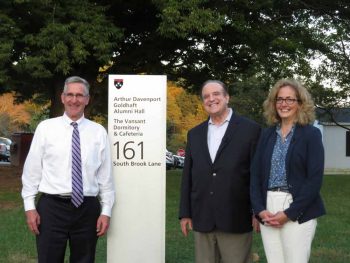
Dr. Barbara Dallap-Schaer, Medical Director of the New Bolton Center (right) with Senator Dinniman (center) and Pa. Secretary of Agriculture Russell Redding (left) during a tour of the New Bolton Center.
EAST MARLBOROUGH — The equine industry spends $546 million annually on goods, services, wages and salaries in Southeastern Pennsylvania, according to a new study conducted by Delaware Valley University.
The impact of this spending generates $670 million to the regional gross domestic product, supports more than 6,550 jobs, provides almost $160 million in annual payroll, and generates $58 million in tax revenue.
“It’s been said that ‘the horse made Chester County.’” And this study confirms what so many of us have long known. The horse not only made Chester County what it is in terms of open space, it continues to make Chester County money, it results in jobs, it brings visitors and tourists, and it continues to shape our very landscape,” Dinniman said. “The equine industry is not only part of our heritage, it is engine for growth in our region’s economy.”
The “Contributions of the Equine Industry to the Economy of Southeastern Pennsylvania” study, commissioned by the Chester Delaware County Farm Bureau and supported by state Senator Andy Dinniman and the Pennsylvania Department of Agriculture, was the subject of a recent panel discussion at the University of Pennsylvania’s New Bolton Center. It marks the first time the economic impact of equine agriculture and the equine industry has been quantified at the regional level.
The panel discussion featured equine experts and agricultural leaders, such as:
- Chester County resident and Olympic Medalist Phillip Dutton
- Pennsylvania Secretary of Agriculture Russell Redding.
- Susan Hamley, Executive Director of the Chester County Conference and Visitors Bureau.
- Carl “Bunny” Meister, Real Estate Agent with James A. Cochrane Inc.
- Brian Sanfratello, Executive Secretary of the Pennsylvania Horse Breeders Association.
Dinniman said he couldn’t think of a better place to hold the event and unveil the study’s findings then the New Bolton Center.
Dr. Barbara Dallap-Schaer, Medical Director of the New Bolton Center, opened the program by thanking the study’s participants and supporters, as well as Dinniman and other local legislators for their continued support of agriculture and the equine industry.
“As part of the southeastern Pennsylvania equine community, New Bolton Center is incredibly grateful to the Chester County Farm Bureau for commissioning Delaware Valley University to undertake the study, as well as to Senator Dinniman and the State’s Department of Agriculture for supporting this initiative,” Dr. Dallap-Schaer said. “Penn Vet’s New Bolton Center has a long history of supporting the equine sector through our clinical services ranging from critical care to sports medicine, our diagnostic capabilities, our Field Service program, as well as our renowned standard of care. We are delighted to host tonight’s distinguished group of experts from the equine and agricultural communities as we discuss the equine sector’s impact on our regional economy.”
John Urbanchuk, the study’s Program Director and Assistant Professor and Chair of Agribusiness at Delaware Valley University, summarized the findings saying that while the equine industry has a significant economic impact on the regions, it also plays a tremendous role in preserving open space.
“The industry puts money in the pocket of Chester County,” Urbanchuk said. “And I cannot overestimate the importance of preserving open space. Once you lose that land and you lose it to development, it’s gone.”
Dutton, a six-time Olympian equestrian eventing rider who came to Chester County 25 years ago, said the region has established itself as the place to be for horse sporting and that reputation continues to grow.
“I came to this area and got immersed with some of the best people that service the horse industry. Looking back after six Olympics, I’m proud to say that I’ve been here and it’s helped me immensely to be here,” he said. “The Napa Valley is known for wine. Nashville is known for country music. Detroit for cars. Well, Chester County is known for the horse industry and for sport horses.”
Dutton also said the region’s various horse events, shows, competitions, and training opportunities bring significant income from out of state.
Hamley echoed Dutton’s comments about the equine industry’s far-reaching draw in bringing tourists and visitors to Chester County.
“Outside of the direct economic impact, one of our key selling points in the scenic beauty of our rolling hills and our preserved land,” Hamley said. “Almost 30 percent of the county is permanently preserved land. I don’t know who else can say that but it’s a fabulous attribute. The passion and commitment to maintaining this bucolic environment is part of the lure that brings people here to unwind and relax.”
Meister discussed the equine industry’s role in shaping Chester County’s real estate landscape and its roots in the sport of fox-hunting.
Sanfratello discussed the role of the horseracing industry in supporting jobs and job growth.
“Who does one racehorse employ? About 20 jobs are created by one racehorse in the industry. People don’t think about those who take care of the horses,” he said. “Think about how many jobs we have just from the racing industry in Pennsylvania because of that.”
Dan Miller, President of the Chester Delaware County Farm Bureau, said the study was a major step in gauging the widespread economic impact of equine agriculture in our region and would be incredibly useful to drive policy initiatives that support agriculture, farming, and the horse industry.
“We recognized years ago the amount of equine activity going on in Chester County and Delaware County for a long, long time, but we needed to know more about how the industry was set up and what types of equine it was comprised of so we could advocate better for them,” Miller said.
Redding said that the study filled a vital knowledge gap in recognizing the full picture of the horse industry’s role at the regional and county level.
“The real value is being able to articulate what the equine industry means to this region and this Commonwealth. What does it mean for support for places like the New Bolton Center? What does it for the other policies that go with this conversation?” he said. “It’s the basis for farmland preservation. It’s the basis for preferential tax. It’s the basis for what we do in the racing industry. All of those are pieces that become part of the impact story that we can now tell with this study.”






